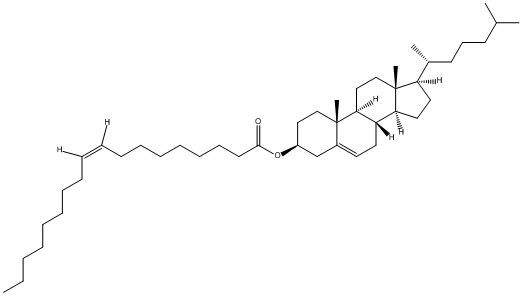Cholesteryl-oleate
General
Type : Cholesterylester || Steroid || Oleate || Phenanthrene
Chemical_Nomenclature : [(3S,8S,9S,10R,13R,14S,17R)-10,13-dimethyl-17-[(2R)-6-methylheptan-2-yl]-2,3,4,7,8,9,11,12,14,15,16,17-dodecahydro-1H-cyclopenta[a]phenanthren-3-yl] (Z)-octadec-9-enoate
Canonical SMILES : CCCCCCCCC=CCCCCCCCC(=O)OC1CCC2(C3CCC4(C(C3CC=C2C1)CCC4C(C)CCCC(C)C)C)C
InChI : InChI=1S\/C45H78O2\/c1-7-8-9-10-11-12-13-14-15-16-17-18-19-20-21-25-43(46)47-38-30-32-44(5)37(34-38)26-27-39-41-29-28-40(36(4)24-22-23-35(2)3)45(41,6)33-31-42(39)44\/h14-15,26,35-36,38-42H,7-13,16-25,27-34H2,1-6H3\/b15-14-\/t36-,38+,39+,40-,41+,42+,44+,45-\/m1\/s1
InChIKey : RJECHNNFRHZQKU-RMUVNZEASA-N
Other name(s) : Oleoylcholesterol, Cholesteryl cis-9-octadecenoate, Oleic acid cholesteryl ester, Cholest-5-en-3-beta-yl oleate, Cholesteryl oleic ester, Cholesteryl oleate, cholesteryl (9Z-octadecenoate)

References (4)
| Title : Novel lipid droplet-associated serine hydrolase regulates macrophage cholesterol mobilization - Goo_2014_Arterioscler.Thromb.Vasc.Biol_34_386 |
| Author(s) : Goo YH , Son SH , Kreienberg PB , Paul A |
| Ref : Arterioscler Thromb Vasc Biol , 34 :386 , 2014 |
| Abstract : Goo_2014_Arterioscler.Thromb.Vasc.Biol_34_386 |
| ESTHER : Goo_2014_Arterioscler.Thromb.Vasc.Biol_34_386 |
| PubMedSearch : Goo_2014_Arterioscler.Thromb.Vasc.Biol_34_386 |
| PubMedID: 24357060 |
| Gene_locus related to this paper: human-LDAH |
| Title : Mammalian carboxylesterases: from drug targets to protein therapeutics - Redinbo_2005_Drug.Discov.Today_10_313 |
| Author(s) : Redinbo MR , Potter PM |
| Ref : Drug Discov Today , 10 :313 , 2005 |
| Abstract : Redinbo_2005_Drug.Discov.Today_10_313 |
| ESTHER : Redinbo_2005_Drug.Discov.Today_10_313 |
| PubMedSearch : Redinbo_2005_Drug.Discov.Today_10_313 |
| PubMedID: 15749280 |
| Title : Structural insights into the lipase\/esterase behavior in the Candida rugosa lipases family: crystal structure of the lipase 2 isoenzyme at 1.97A resolution - Mancheno_2003_J.Mol.Biol_332_1059 |
| Author(s) : Mancheno JM , Pernas MA , Martinez MJ , Ochoa B , Rua ML , Hermoso JA |
| Ref : Journal of Molecular Biology , 332 :1059 , 2003 |
| Abstract : Mancheno_2003_J.Mol.Biol_332_1059 |
| ESTHER : Mancheno_2003_J.Mol.Biol_332_1059 |
| PubMedSearch : Mancheno_2003_J.Mol.Biol_332_1059 |
| PubMedID: 14499609 |
| Gene_locus related to this paper: canru-2lipa |
| Title : Purification, cloning, and expression of a human enzyme with acyl coenzyme A: cholesterol acyltransferase activity, which is identical to liver carboxylesterase - Becker_1994_Arterioscler.Thromb_14_1346 |
| Author(s) : Becker A , Bottcher A , Lackner KJ , Fehringer P , Notka F , Aslanidis C , Schmitz G |
| Ref : Arterioscler Thromb , 14 :1346 , 1994 |
| Abstract : Becker_1994_Arterioscler.Thromb_14_1346 |
| ESTHER : Becker_1994_Arterioscler.Thromb_14_1346 |
| PubMedSearch : Becker_1994_Arterioscler.Thromb_14_1346 |
| PubMedID: 8049197 |
| Gene_locus related to this paper: human-CES1 , pig-EST1 |